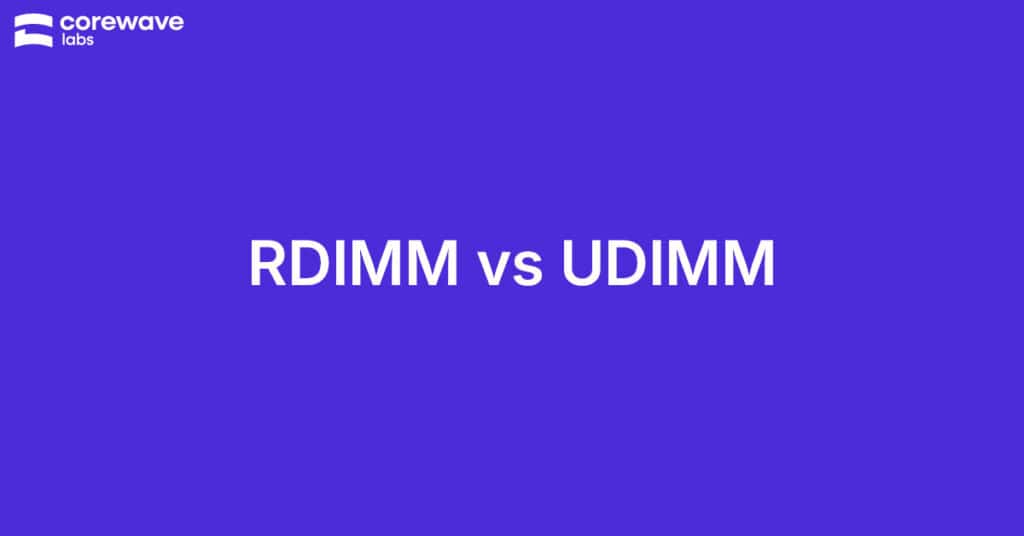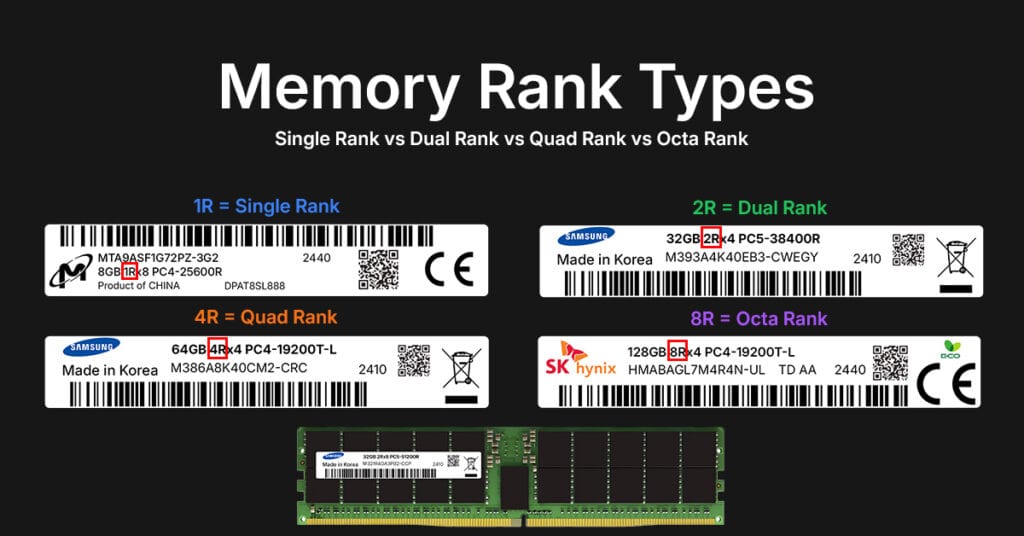Updated on:
| Written by:
RDIMM vs UDIMM: What’s the Difference & Which to Use?
- 1. What Is UDIMM (Unbuffered DIMM)?
- 2. What Is RDIMM (Registered DIMM)?
- 3. RDIMM vs UDIMM: Feature Comparison Table
- 4. Are RDIMM and UDIMM Interchangeable?
- 5. When to Choose RDIMM or UDIMM
- 6. Real-World Compatibility Examples
- RDIMM vs UDIMM Related Questions
- Conclusion: RDIMM vs UDIMM — Which Should You Choose?
Key Takeaways
- UDIMM = Unbuffered, lower latency, lower cost, limited to 2–4 ranks
- RDIMM = Registered, higher capacity (up to 8 ranks), more stable under load
- Not interchangeable — mixing UDIMM and RDIMM can cause boot errors
- Use UDIMM for desktops or light server loads
- Use RDIMM for dual-socket servers, virtualization, and mission-critical apps
Want to see how RDIMM and UDIMM compare to LRDIMM as well? Check out our complete DIMM comparison guide for a broader breakdown across all three memory types.
1. What Is UDIMM (Unbuffered DIMM)?
UDIMM stands for Unbuffered Dual In-Line Memory Module. If you want a deeper breakdown of how it works and where it’s used, check out our dedicated UDIMM guide. It’s a type of RAM that connects directly to the memory controller — without an intermediate register or buffer. This direct path results in lower latency, but it also limits the number of DIMMs the system can reliably support.
Unlike RDIMMs, which add a buffer to reduce electrical load and improve signal integrity, UDIMMs place more strain on the memory controller. That’s why they’re generally used in:
- Consumer desktops
- Workstations
- Entry-level servers where high capacity and ECC aren’t critical
Note: While some UDIMMs support ECC (Error-Correcting Code), most consumer motherboards can’t use this feature — and servers typically expect RDIMMs instead.
UDIMM Key Characteristics:
- No register between DRAM and memory controller
- Lower latency, but lower stability at high DIMM counts
- 2–4 ranks max per channel before system instability occurs
- Used where cost and speed matter more than scalability
In short: UDIMMs are ideal for low to moderate workloads where ECC isn’t required and memory density is modest.
2. What Is RDIMM (Registered DIMM)?
RDIMM stands for Registered Dual In-Line Memory Module. It includes a register (buffer) between the DRAM chips and the memory controller — typically located on the CPU. This register reduces electrical load on the controller, improves signal integrity, and allows the system to handle more memory modules reliably. You can explore the technical benefits and typical RDIMM use cases in our full What is RDIMM? article.
The result? Greater scalability, higher capacity, and increased stability, especially in multi-DIMM or dual-socket server environments.
All RDIMMs support ECC (Error-Correcting Code) by default, making them essential in systems where uptime, data integrity, and crash-resilience matter.
RDIMM Key Characteristics:
- Includes a command/address buffer for stability
- Slightly higher latency than UDIMM, but negligible in most server use cases
- Supports more DIMMs per channel and higher overall capacity (often up to 8 ranks)
- Designed for enterprise-grade servers, virtualization, and memory-heavy workloads
You’ll typically find RDIMMs in:
- Data center servers (Dell PowerEdge, HPE ProLiant, etc.)
- Cloud infrastructure nodes
- Scientific computing, virtualization hosts, and enterprise databases
In short: RDIMMs are built for reliability, scalability, and ECC performance — ideal for any system where memory load is serious and downtime isn’t an option.
3. RDIMM vs UDIMM: Feature Comparison Table
This side-by-side breakdown shows how RDIMM vs UDIMM stack up across the features that matter most for system builders and IT teams.
| Feature | UDIMM | RDIMM |
|---|---|---|
| Buffer/Register | None – direct to memory controller | Yes – uses register between DRAM and controller |
| ECC Support | Optional (depends on module + motherboard) | Always supported |
| Latency | Lower (due to direct connection) | Slightly higher (due to register) |
| Max Capacity | Lower – 2 to 4 ranks per channel | Higher – up to 8 ranks per channel |
| Typical Module Sizes | 4GB, 8GB, 16GB, 32GB, 64GB | 8GB, 16GB, 32GB, 64GB, 128GB, 256GB |
| Maximum System Memory | ~128GB to 256GB (depends on CPU/motherboard limits) | 512GB to 2TB+ (typical on dual-socket servers) |
| Power Efficiency | Slightly better at low loads | More efficient at high loads due to signal stability |
| Cost | Lower | Higher |
| System Use | Desktops, workstations, small servers | Enterprise servers, virtualization, critical workloads |
| Compatibility | Limited ECC/server compatibility | Server-grade platforms only |
4. Are RDIMM and UDIMM Interchangeable?
No — RDIMM and UDIMM are not interchangeable.
They may look similar, but they operate differently at the electrical level and are often keyed differently on DDR5 and DDR4 platforms.
Here’s why they’re not compatible:
- RDIMMs include a register (buffer) that changes how signals are managed.
- UDIMMs connect directly to the memory controller without a buffer.
- Most motherboards and CPUs support only one type — trying to mix them will usually result in boot errors or system instability.
- On DDR5 systems, RDIMM and UDIMM modules often have different notch positions, making them physically incompatible.
You cannot mix RDIMM and UDIMM in the same system. Even if they fit (e.g., some DDR3 platforms), the system will either refuse to boot or run unreliably.
5. When to Choose RDIMM or UDIMM
Choosing between RDIMM and UDIMM isn’t about one being “better” — it’s about what your system demands. Here’s how to make the right call:
Choose RDIMM if you:
- Run enterprise-grade servers (e.g., Dell PowerEdge, HPE ProLiant)
- Need large memory capacity (e.g., 512GB+ RAM)
- Rely on ECC for data integrity
- Operate dual-socket or multi-channel platforms
- Run virtualization, databases, or mission-critical workloads
RDIMMs are built for scale, uptime, and heavy memory loads.
Choose UDIMM if you:
- Use a desktop PC or workstation
- Need up to 128–256GB RAM, not more
- Want lower latency and lower cost
- Don’t need ECC, or use ECC UDIMM in compatible motherboards
- Run productivity software, development tools, or light VMs
UDIMMs are perfect for leaner systems where every millisecond and euro count.
6. Real-World Compatibility Examples
Still unsure what your system supports? Here are common platforms and the memory types they require:
Dell PowerEdge R740
- RDIMM only
- Supports ECC, high capacity, and multi-socket configs
- Mixing with UDIMM = not supported
HP Z Series Workstations (e.g., Z6, Z8)
- ECC UDIMM or RDIMM, depending on model
- Check motherboard specs: some support ECC UDIMM, some require RDIMM
AMD EPYC Platforms (Genoa, Milan)
- RDIMM only
- Supports massive memory bandwidth and capacity
- ECC required for stability
Intel Xeon Scalable Systems
- Typically RDIMM
- Supports high-rank modules for virtualization and AI workloads
- ECC + buffer helps prevent silent data corruption
Consumer Desktop Boards (Intel Core, AMD Ryzen)
- UDIMM or ECC UDIMM
- No support for RDIMM
- Some AMD Ryzen Pro and Intel W-series chips support ECC UDIMM if enabled by BIOS
RDIMM vs UDIMM Related Questions
Can I use RDIMM instead of UDIMM?
No. RDIMMs are not compatible with systems designed for UDIMMs. The memory architecture and signal handling are different, and mixing them will cause boot failure.
What is the main difference between RDIMM vs UDIMM?
The main difference in RDIMM vs UDIMM is the register buffer. RDIMM uses a buffer for better stability and higher capacity in servers, while UDIMM connects directly to the memory controller for lower latency and cost but less scalability.
Can I mix UDIMM and RDIMM in the same system?
No. Mixing RDIMM and UDIMM in the same system is not supported and will prevent the system from booting.
Does RDIMM always support ECC?
Yes. All RDIMMs are ECC-enabled by default, making them suitable for systems requiring error correction and data integrity.
When should I choose UDIMM over RDIMM?
Use UDIMM for desktops, workstations, or entry-level servers where cost and lower latency are more important than memory capacity or ECC.
Can I put UDIMM in a DIMM slot?
Yes, UDIMM is a type of DIMM, so it fits physically. However, your motherboard must support UDIMMs, and not all DIMM slots accept both RDIMM and UDIMM.
Is UDIMM the same as DIMM?
Not exactly. DIMM is the general term (Dual In-Line Memory Module). UDIMM is a specific type — Unbuffered DIMM — used mostly in desktops and entry-level servers.
Can I use server RAM in my PC?
Only if it’s ECC UDIMM and your motherboard supports it. Most desktop boards don’t support RDIMM, so full server-grade memory usually won’t work in consumer PCs.
Conclusion: RDIMM vs UDIMM — Which Should You Choose?
So when choosing between RDIMM vs UDIMM if you’re running a workstation or desktop PC, UDIMM is usually the right choice — lower cost, lower latency, and just enough capacity for most workloads.
If you’re building or upgrading an enterprise server, RDIMM is the clear winner. It offers ECC, stability, and higher capacity, making it essential for virtualization, critical apps, and dual-socket systems.
About the Author

Edgars Zukovskis
Board Member | CoreWave Labs
14+ years of expertise helping telecom operators, datacenters, and system integrators build efficient, cost-effective networks using compatible hardware solutions.
Server Memory for Top Brands
Select Your Server Brand to Find Compatible Memory
Recommended Reads
Discover insights to power your infrastructure.


